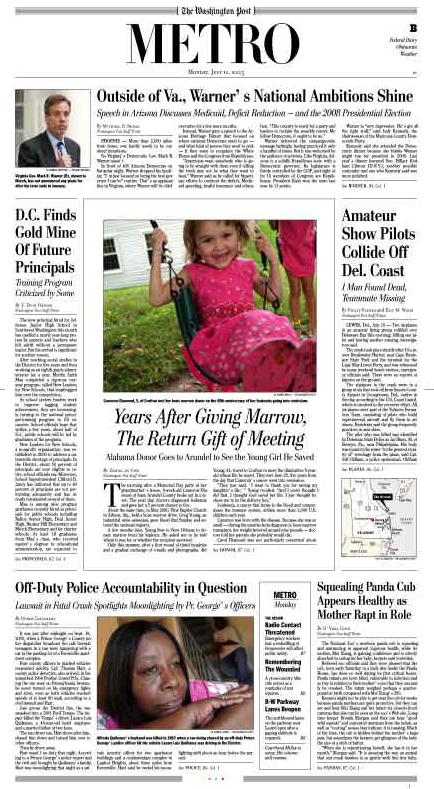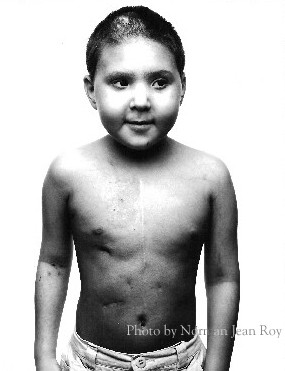
So early this morning before everyone woke up I sat in the basement thinking about everyone who was very sick and is alive now.
Amitai
Dan Brown
Lance Armstrong
Mary Beth
And when I came upstairs, Mom showed me this article from today's newspaper. There is also a story about the new baby panda at the zoo.
The panda babies never seem to make it, but it looks like this one has a chance.
This little girl's transplant was just a few months after yours. She looks good.

Years After Giving Marrow, The Return Gift of Meeting
Alabama Donor Goes to Arundel to See the Young Girl He Saved
By Daniel de Vise
Washington Post Staff Writer
Monday, July 11, 2005; B01
The morning after a Memorial Day party at her grandmother's house, 6-week-old Cameron Diamond of Anne Arundel County broke out in a fever. The next day, doctors diagnosed leukemia and gave her a 5 percent chance to live.
About the same time, in May 2000, First Baptist Church in Athens, Ala., held a bone marrow drive. Greg Young, an industrial valve salesman, gave blood that Sunday and entered the national registry.
A few months later, Young flew to New Orleans to donate marrow from his hipbone. He asked not to be told whom it was for or whether the recipient survived.
Only this summer, after a first round of timid inquiries and a gradual exchange of e-mails and photographs, did Young, 41, travel to Crofton to meet the diminutive 5-year-old whose life he saved. They met June 25, five years from the day that Cameron's cancer went into remission.
"They just said, 'I want to thank you for saving my daughter's life,' " Young recalled. "And I never thought I did that. I thought God saved her life. I just thought he chose me to be the delivery boy."
Leukemia, a cancer that forms in the blood and compromises the immune system, strikes more than 2,000 U.S. children each year.
Cameron was born with the disease. Because she was so small -- during the months from diagnosis to bone-marrow transplant, her weight hovered around nine pounds -- doctors told her parents she probably would die.
Carol Diamond was not particularly concerned about Cameron when she took her to the pediatrician on the Tuesday after Memorial Day weekend five years ago. "She was just a little warm," Diamond recalled.
One day, several tests and three medical facilities later, the Diamonds were led into a private room in the neonatal intensive care unit at the University of Maryland Medical Center, where a doctor told the parents, "She's probably not going to make it."
That was on a Wednesday. By Friday, Cameron was undergoing chemotherapy. Hospital employees who left their shifts that day seemed joyously surprised, the mother recalled, when they returned Monday and found the patient alive.
Cameron needed a transfusion of healthy bone marrow to survive. But the best hope for a donor evaporated when Cameron's older sisters, Julia and Amanda, tested negative for a match.
Finding a suitable bone-marrow donor means hunting for a match on at least five of six genetic markers in the patient's white blood cells.
In summer 2000, when the National Marrow Donor Program searched its registry of about 4 million names (now more than 5 million), it found just four perfect matches for Cameron. All four were contacted. Only Young called back.
"They said: 'You could potentially be a match. Could you do this?' " Young recalled. "I thought maybe I was one of 100 people who could do this, but they said, 'No, you're the match.' That's when it kind of hit me."
The caller told Young that because the patient was an infant, they would not need very much marrow. That was more than he wanted to know.
"At the time, I just wanted to be anonymous," he said. "I didn't really feel like I was doing anything that special, and I didn't want the attention. I didn't really want to know if she didn't make it."
Cameron's life hung on the actions of a man she never had met. "I thought he was going to back out," Carol Diamond recalled. "And I'm not sure why." There was also a chance, a good chance, that the transplant would not work.
Before Cameron could receive the transplant, she had to undergo a five-day regimen: 15 minutes of intense radiation daily, focused on every bone in her body, to cleanse it of cancerous cells.
On the morning of Nov. 16, 2000, doctors harvested bone marrow from Young in New Orleans and put it on a plane to Baltimore, where it was transfused into Cameron that night. Cameron's weakened body developed a fever during the procedure. Doctors put her on three antibiotics as her temperature rose to 104.
"I can think of three times when I really thought we were at death's door," said B.J. Diamond, Cameron's father. "That was one."
The fever broke.
The Diamonds left the hospital Dec. 8 and moved into a rental apartment a few minutes away. Doctors told them to be within a 10-minute drive in case Cameron's temperature climbed again. She wore a mask over her nose and mouth for the next three months.
Donors and recipients are forbidden to have direct contact for the first year after a marrow transplant. On Nov. 16, 2001, the Diamonds placed their contact information on the registry and requested the identity of the donor.
Young remained reluctant. His wife, Deana, urged him to change his mind, telling him, "If it was your kid, you'd want to know."
The Diamonds packed up a box and sent it to Alabama, enclosing a home video, pictures, a cookbook assembled by friends and a CD of songs that the family identified with their daughter. One was Seals & Crofts's "Diamond Girl."
The Youngs wrote back. And then they called.
"I said: 'My name is Deana Young. Do you know who I am?' " she recalled. "And B.J. said, 'I'm looking at your picture on the refrigerator.' "
In November 2002, the Youngs opened a jewelry and gift store in Athens and named it Cameron's Store. The store remained open until this February.
The Youngs traveled to Crofton last month to help celebrate the anniversary of Cameron's remission.
They hugged; they wept. Cameron presented Greg Young with a plate decorated with an angel, its wings formed in the shape of her tiny hands, inscribed with the words, "Thank you my angel, Greg."
© 2005 The Washington Post Company


No comments:
Post a Comment